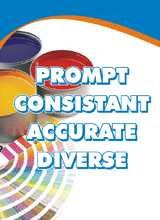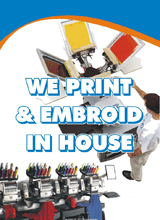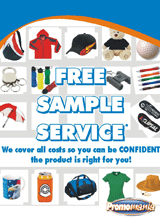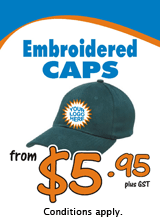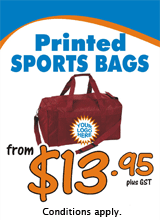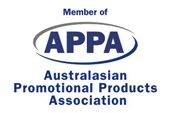Decoration Solutions
Embroidery

Embroidery uses thread stitched by a computer driven machine on to a product in different patterns to best represent the artwork or logo.
Advantages: Small runs are usually very price effective. The result has a professional appearance that does not wear, crack or fade.
Disadvantages: Complex or detailed images cannot be accurately reproduced. Price is determined by the quantity of stitches therefore large images are generally too expensive.
Setup: Although there is an initial setup cost involving the digitising of the artwork repeat orders do not require any further costs.
Suitable Products Include: Clothing, Caps, Bags, Towels & most fabrics.
Screenprinting
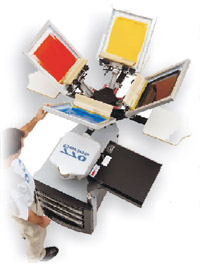
Involves the passing of ink through a mesh or 'screen' that has been stretched on a frame, and to which a stencil has been applied. The stencil openings determine the image that will be printed.
Advantages: Once the screen and machine is setup, screenprinting is a price effective way of decorating products regardless of the artwork size.
Disadvantages: Small runs are usually costly due to the labour involved with setup. Some types of materials such as synthetics can have difficulty with accepting the inks which can lead to dye migration (colour of the fabric leaching through the printed ink).
Setup: Initially there is a charge to create the photographic film required to produce the stencils. All other setup costs including screen preparation and machine make ready are incorporated into the screenprinting volume rates.
Suitable Products Include: Clothing, Bags, Ribbons, Signs, Stickers.
Laser Engraving

Is the practice of using lasers to engrave or mark an object. A computer system is used to drive the movements of the laser head. Despite this complexity, very precise and clean engravings can be achieved at a high rate.
Advantages: Engraving is a permanent etched image usually onto substrates such as wood, plastic, glass and metal.
Disadvantages: Size of the image is usually a factor in determining price. Curved surfaces can also pose a problem as the image can distort.
Setup: There is an initial cost to create the computer program and make ready the machine for each specific job. Repeat order only requires the machine setup charge.
Pad Printing

Pad printing is a printing process that can transfer a 2-D image onto a 3-D object. This is accomplished using a stamp printing process that involves an image being transferred with ink from the printing plate via rubber pad onto a product. The rubber pad conforms to the surface of the product thus leaving the image. Pad printing is used for printing on otherwise impossible products such as stress balls, curved objects, keypads and most awkwardly shaped smaller promotional products.
Advantages: Almost any shape object can be printed using pad printing. Once the machine is set, the process is very fast to print, accurate and sharp. Very price effective with large runs.
Disadvantages: Wear and tear of the product can result in the image becoming faded or worn looking especially on such items as keyrings which are continually being rubbed.
Setup: There is an initial cost to create the plate and make ready the machine for each specific job. Repeat order only requires the machine setup charge as the plate can generally be reused for its lifespan.
Suitable Products Include: Smaller Promotional items like keyrings, pens, calculators, stress balls as well as some larger giftware such as coffee mugs. giftware.
Digital Transfers

The latest in heat applied transfers - your image is digitally printed using solvent based inks onto a very thin membrane material which is cut to shape then heat applied under pressure on to the product. Cost is determined by size as well as how complex the logo is to cut to shape.
Advantages: Small runs and very cost effective especially when several colours or full colour is required.
Disadvantages: The area where the transfer is applied to becomes ‘non-breathable’ due to the solid nature of the material. Over time the image can fade and wear however usually will outlast the products typical lifespan.
Setup: Other than the initial artwork there are no further setup costs.
Suitable products include: Clothing, Caps and Bags.
Plastisol Transfers
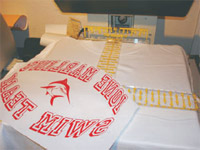
Plastisol transfers are like digital transfers only that they leave behind just the ink as they do not require a membrane. They are screen printed in reverse on a special heat release transfer paper. Once the design is printed it is backed up with a glue. When the transfer is heated on to the product the glue melts and attaches the ink to the product. Pricing is based on the size, quantity and number of colours.
Advantages: High quality edge definition is achievable on rough or textured fabrics. The transfers can be printed in bulk then applied to the products only when required. Multiple logos of different sizes can be printed at once eliminating extra setup costs.
Disadvantages: Extra costs are involved as the process requires more labour and materials.
Suitable products include: Clothing, caps & bags.
Die Cut or Cad Cut Transfers
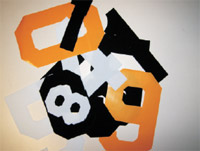
Typically in the form of numerals pre-made die cut numbers in numerous styles and sizes are used for applying to sporting jerseys and similar. They are cut from a solid but thin membrane material then positioned on the garment and heat applied under pressure. Cad cut transfers are similar only they are made to order enabling any reasonably simple shapes, text or designs to be cut from the same membrane material.
Advantages: Individual, personal text or names & sequential numbers can be applied to the garments
Disadvantages: The area where the transfer is applied becomes ‘non-breathable’ due to the solid nature of the material. Some lighter colours can be effected by dye migration which is the leaching of the garment colour showing through the transfer - typically when white is applied to darker polyester garments.
Setup: Other than the initial artwork there are no further setup charges.
Suitable products include: Football jerseys, sporting teams & memorabilia garments.
Sublimation

Dye sublimation printing is the process of transferring a digitally printed typically photographic image onto any 100% polyester fabric or any surface that is coated with a special polyester resin. The image is printed in reverse onto a release paper using special inks and then is transferred onto the product using a heat press. The ink turns into a gas and attaches itself on to the polyester. The result is a high quality, photographic resolution with bright permanent colours that wont fade or rub off.
Advantages: Small runs or ‘one offs’ are easily produced at reasonable cost.
Disadvantages: Only white or light coloured substrates can be used as the inks are transparent in nature therefore the colour of the substrate will show through the transferred image. Some fabrics may leave a mark in the fabric caused by the edge of the transfer or have tiny imperfections of colour caused by specs of dust caught in the fabric during manufacture.
Setup: Other than the initial artwork preparation there is no additional setups.
Products available: These include clothing, mugs, stubbie holders and a large and continual growing list of giftware options like cheeseboards, keyrings, ties & jewelry.

